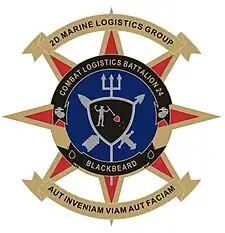Combat Logistics Battalion 24
Combat Logistics Battalion 24 (CLB-24) is a logistics battalion of the United States Marine Corps. They are part of Combat Logistics Regiment 2, 2nd Marine Logistics Group. The unit is based out of the Marine Corps Base Camp Lejeune, North Carolina and is in direct support of the 24th Marine Expeditionary Unit (24th MEU) .
| Combat Logistics Battalion 24 | |
|---|---|
 CLB-24 insignia | |
| Active | 1944–present |
| Country | United States |
| Branch | USMC |
| Type | Logistics |
| Part of | 24th Marine Expeditionary Unit 2nd Marine Logistics Group |
| Garrison/HQ | Marine Corps Base Camp Lejeune |
| Motto(s) | "Aut Inveniam Viam Aut Faciam" (Either Find a Way or Make One) |
| Engagements | Operation Desert Storm Operation Iraqi Freedom Operation Enduring Freedom |
| Commanders | |
| Current commander | LtCol Stephen G. Page |
Mission
The mission of CLB-24 is to provide timely, reliable, and continuous support to 24th MEU in support of the MEU commander's tactical mission and concept of operations; and to conduct, on order, Non-Combatant Evacuation Operations, Medical treatment and evacuation of casualties on a large scale, and Humanitarian Aid and Assistance operations.
History
1944–1949
Activated 1 August 1944 at Oahu, Territory of Hawaii, as Headquarters Company, 8th Field Depot, Supply Service, Fleet Marine Force
Participated in the following World War II Campaign: Iwo Jima
Relocated during April 1945 to Hilo, Territory of Hawaii
Redesignated 1 June 1945 as Headquarters Company, Headquarters and Service Battalion, 8th Service Regiment, Service Command, Fleet Marine Force
Relocated during April 1945 to Sasebo, Japan
Relocated during August–September 1946 to Camp Lejeune, North Carolina, and reassigned to 2d Marine Division, Fleet Marine Force
Redesignated 15 December 1946 as Headquarters Company, Headquarters and Service Battalion, 2d Combat Service Group, Medium, 2d Marine Division, Fleet Marine Force
1950–1959
Redesignated 13 October 1950 as Headquarters and Service Battalion, 2d Combat Service Group, Service Command, Fleet Marine Force, Atlantic
Assigned 1 April 1951 to Force Troops, Fleet Marine Force, Atlantic
Redesignated 1 July 1956 as Headquarters and Service Battalion, 2d Combat Service Group, Force Troops, Fleet Marine Force, Atlantic
Redesignated 1 March 1957 as Headquarters and Service Battalion, 2d Force Service Regiment, Force Troops, Fleet Marine Force, Atlantic
1960–1989
Elements participated in the Cuban Missile Crisis, October–December 1962
Redesignated 1 October 1975 as Headquarters and Service Battalion, Force Troops/2d Force Service Support Group, Fleet Marine Force, Atlantic
Redesignated 30 June 1978 as Headquarters and Service Battalion, 2d Force Service Support Group, Fleet Marine Force, Atlantic
Element participated in operations in the Persian Gulf, April 1988
1990–2004
Participated in Operations Desert Shield and Desert Storm, Southwest Asia, as the Direct Support Command, 1st Force Service Support Group, December 1990 – March 1991
Elements participated in Haitian refugee operations, Cuba, November 1991 – April 1992, November 1992 – February 1993, and May–October 1994
Elements provided disaster relief support to Dade County, Florida, after Hurricane Andrew, September–October 1992
Elements participated in Operation Provide Promise, Bosnia, March–August 1994
Deployed during December 2002 to Kuwait in support of Operation Enduring Freedom
Participated in Operation Iraqi Freedom, Iraq, March–June 2003
CLB-24 is currently supporting 24th MEU operations.[1]
2008
In February 2008, the CLB 24 began deploying its Marines to Kandahar, Afghanistan. They began their combat operations on April 15, 2008. CLB 24 made the initial push to FOB Bastion, In route they Hit a powerful improvised explosive device hidden in a culvert beneath the road detonated around midnight outside of Kandahar killing Battalion Sergeant Major, 1st Sgt. Luke J. Mercardante and Cpl. Kyle Wilks and Two other Marines were injured, one seriously. The blast gouged a hole 12 feet wide and 6 feet deep, stopping the convoy.
Canadian troops from a nearby outpost filled in the crater, allowing the convoy to get moving again to FOB Bastion. The Marines then pushed further into the Taliban stronghold to FOB Dyer and Garmsir, Helmand province around April 24.
This was the first major American operation in the region in years. By 1 June 2008, the Taliban were pushed out of Garmser. By mid-July, after a month and a half of heavy combat, the MEU was reporting that they had killed over 400 Taliban fighters in the Garmser area. Combat operations ended in September, 2008 and Marines started to return home by October, 2008.
pushed Marines of Garmsir 29 April in the first major American operation in the region in years. By 1 June 2008, the Taliban were pushed out of Garmser. By mid-July, after a month and a half of heavy combat, the Marines were reporting that they had killed over 400 Taliban fighters in the Garmser area.
Gallery
 Old Battalion Insignia
Old Battalion Insignia
See also
References
- "CLB-24 supports the MEU, more". Archived from the original on 9 September 2008. Retrieved 13 September 2008.
- "History of MSSG-24". 24th MEU Service Support Group, USMC. Archived from the original on 14 October 2007. Retrieved 19 November 2007.
